
Back Escureixiu AN غروب Arabic ܥܪܒܐ ܕܫܡܫܐ ARC غروب ARY Aséu AST Jayp'u Aymara Günəşin batması Azerbaijani Saulielaidā BAT-SMG Pagsolnop kan saldang BCL Заход Byelorussian

Sunset (or sundown) is the disappearance of the Sun at the end of the Sun path, below the horizon of the Earth (or any other astronomical object in the Solar System) due to its rotation. As viewed from everywhere on Earth, it is a phenomenon that happens approximately once every 24 hours, except in areas close to the poles. The equinox Sun sets due west at the moment of both the spring and autumn equinoxes. As viewed from the Northern Hemisphere, the Sun sets to the northwest (or not at all) in the spring and summer, and to the southwest in the autumn and winter; these seasons are reversed for the Southern Hemisphere.
The time of actual sunset is defined in astronomy as two minutes before the upper limb of the Sun disappears below the horizon.[1] Near the horizon, atmospheric refraction causes sunlight rays to be distorted to such an extent that geometrically the solar disk is already about one diameter below the horizon when a sunset is observed.

Sunset is distinct from twilight, which is divided into three stages. The first one is civil twilight, which begins once the Sun has disappeared below the horizon, and continues until it descends to 6 degrees below the horizon. The early to intermediate stages of twilight coincide with predusk. The second phase is nautical twilight, between 6 and 12 degrees below the horizon. The third phase is astronomical twilight, which is the period when the Sun is between 12 and 18 degrees below the horizon.[2] Dusk is at the very end of astronomical twilight, and is the darkest moment of twilight just before night.[3] Finally, night occurs when the Sun reaches 18 degrees below the horizon and no longer illuminates the sky.[4]
Locations further north than the Arctic Circle and further south than the Antarctic Circle experience no full sunset or sunrise on at least one day of the year, when the polar day or the polar night persists continuously for 24 hours. At latitudes greater than within half a degree of either pole, the sun cannot rise or set on the same date on any day of the year, since the sun's angular elevation between solar noon and midnight is less than one degree.
- ^ Ridpath, Ian (2012-01-01), "sunset", A Dictionary of Astronomy, Oxford University Press, doi:10.1093/acref/9780199609055.001.0001, ISBN 978-0-19-960905-5, retrieved 2021-10-05
- ^ "Definitions from the US Astronomical Applications Dept (USNO)". Archived from the original on 2015-08-14. Retrieved 2016-06-17.
- ^ "Full definition of Dusk".
- ^ "Sunset vs Dusk [What Is The Difference Between The Two?]". Astronomy Scope. 2020-12-03. Retrieved 2021-10-03.